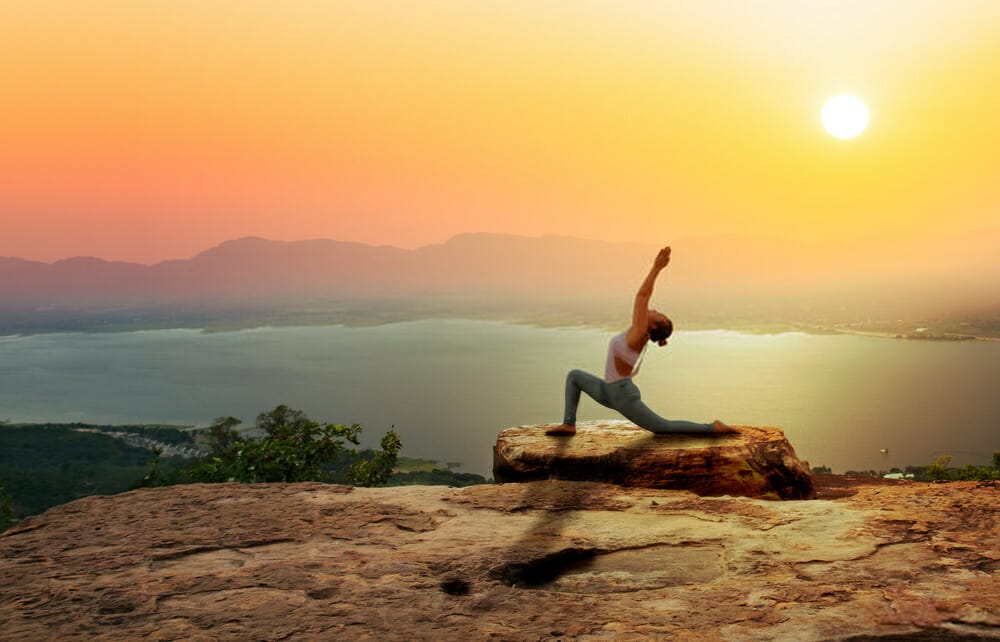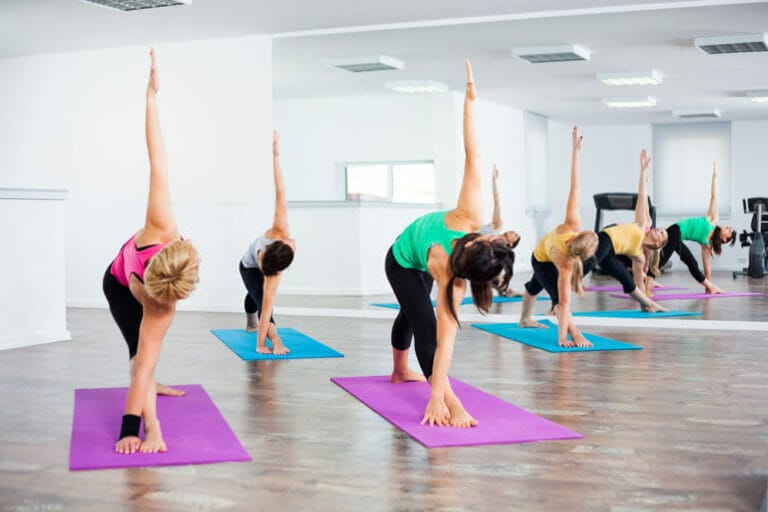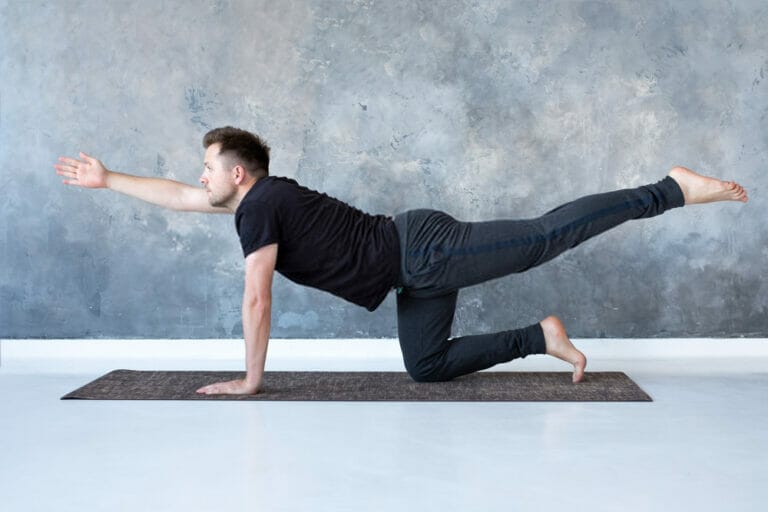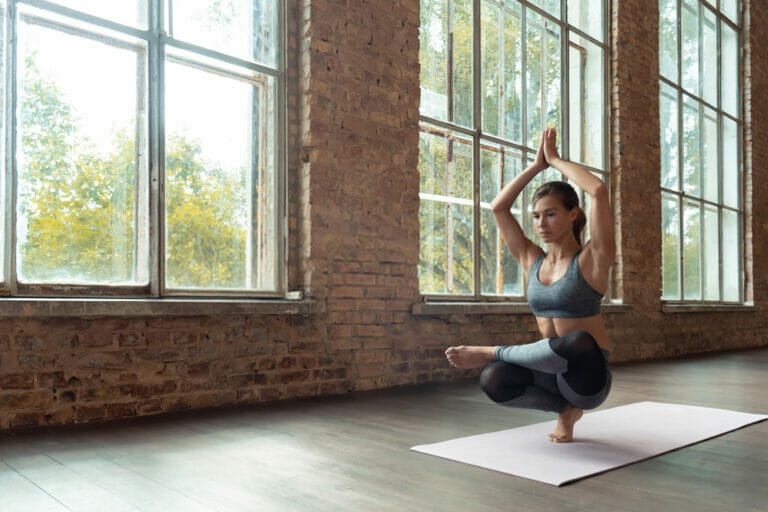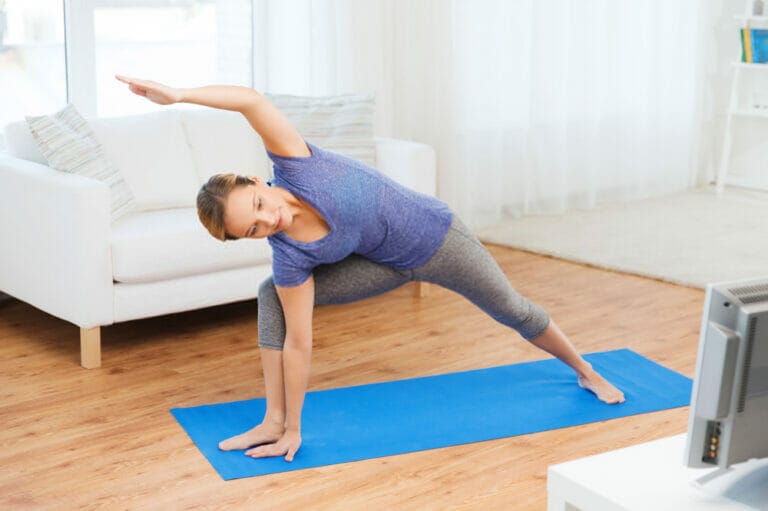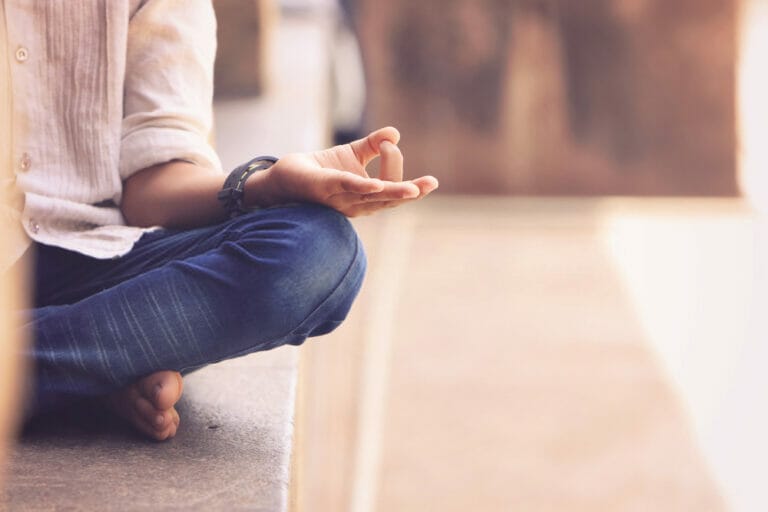Bikram Yoga – All That You Need To Know!
Bikram Yoga is one of the few fitness systems that has stood the test of time.
Bikram Choudhury was created in the 1960s, and since then, it has been practised worldwide.
Bikram teaches his students to hold postures for 20-minutes non-stop in a room heated to a constant of between 68°F and 105°F.
It does a great workout and is used by people who want to lose weight, gain muscle tone, and improve overall health and wellness.
In this article, we'll take a look at the history of Bikram Yoga, how it works, why it works, where you can go to learn more and the many health benefits that come with practising this ancient fitness system.
Let’s start with a look at the history of Bikram Yoga.
What is Bikram yoga, And who is the founder?
This form of yoga consists of 26 postures performed in a sweltering room (105 degrees) and humidified.
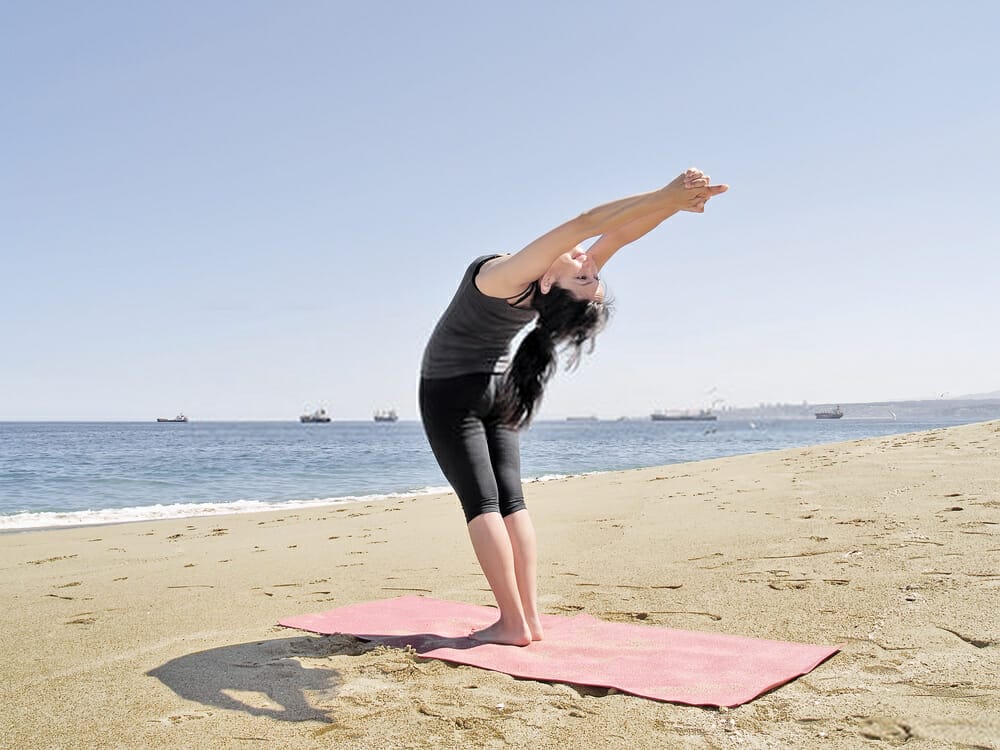
The heat, according to instructors, is a tool that allows you to restart your metabolism and work through any tightness, aches, or pains.
The following are examples of postures you have to perform:
- Deep breathing.
- Tree and Eagle are examples of balance poses.
- Standing Head to Knee and Separate Leg Stretching Pose are examples of deep stretching.
- Cobra and Bow Pose are examples of backbends.
- Fixed Firm Pose hip openers.
Bikram yoga is named after its creator, Bikram Choudhury. He began practising yoga when he was 17 years old to recover from a knee injury.
Next, he started studying postures, breathing techniques, and meditation. He eventually became a certified teacher.
Bikram devised his now-famous series of poses after effectively mending the injury with a regular yoga practice.
He went on to build Bikram's Yoga College of India, and his students have gone on to open hundreds of studios all over the world.
Can anybody do Bikram Yoga?
Despite the heated room and rigorous poses, Bikram Yoga is a very safe and gentle exercise. The poses and movements were specially designed to strengthen the body, improve posture and relieve pain.
It can be recommended to people of all ages – from young to seniors – so long as they're healthy enough to do it.
For example, pregnant women should check with their doctor before practising Bikram Yoga for people with heart, back, or joint problems.
Is Bikram yoga the best for beginners?
As far as yoga goes, yes. Bikram Yoga is one of the best, most effective types of yoga for beginners to try out.
It can be challenging at first because of the number of postures and physical moves involved, but then it's also one of the safest yoga forms because a teacher supervises it.
You’ll be guided through each pose step-by-step, so there’s no way you’ll hurt yourself if you’re doing everything correctly.
It's also a great way to lose weight and tone up, and you'll feel the difference when you leave the class.
What are the 26 postures in Bikram yoga?
Let us take a look at the Bikram yoga 26 poses:
Standing Deep Breathing: Pranayama
A Bikram yoga sequence begins with a pranayama breathing exercise in a standing position. Then, a deep inhale and exhale the body oxygen boosts circulation and improves concentration by utilizing optimal lung capacity.
Half Moon Pose
Ardha Chandrasana, or Half Moon Pose, is the following pose. In Bikram yoga, this position is known as Standing Side Stretch, although in other yoga forms, it is known as Standing Side Stretch.
This pose strengthens the stomach muscles and spine, as well as stimulates the digestive organs.
Awkward Pose
Utkatasana, or Awkward Pose, comes next. In different yoga traditions, this pose, also known as Chair Pose, strengthens the lower body while improving blood circulation.
Eagle Pose
Garudasana, or Eagle Pose, will test your balance. It is the only posture that strengthens, stretches, and increases mobility in all of the body’s major joints.
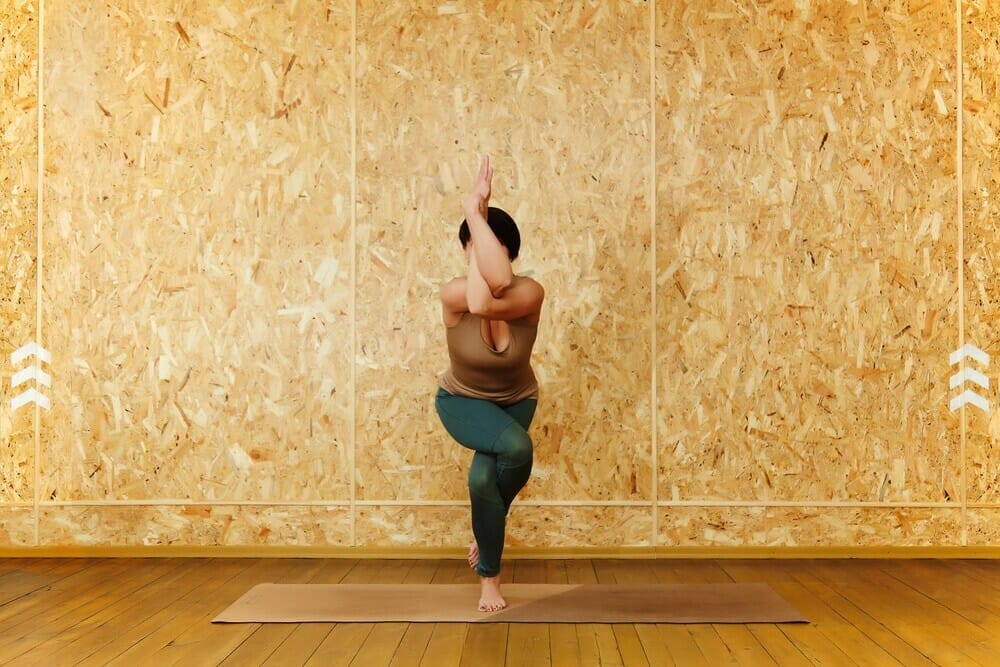
Standing Head-to-Knee Pose
Standing Head-to-Knee Pose, also known as Dandayamana Janusirsana, is a hard-balance posture that uses the entire body.
This position strengthens explicitly and extends the legs, core, and arms while also improving attention.
Standing Bow-Pulling Pose
The next transition is into Dandayamana-Dhanurasana, or Standing Bow-Pulling Pose, which continues the balancing theme.
This position enhances concentration and patience while improving strength and flexibility throughout the body.
Furthermore, the Bikram method promotes this pose as the only one that allows blood to flow from one side of the body to the other, thereby equalizing circulation.
Balancing Stick Pose
Tuladandasana, or Balancing Stick Pose, is the second pose in the Bikram sequence. This pose boosts circulation while requiring balance, resolve, and core strength.
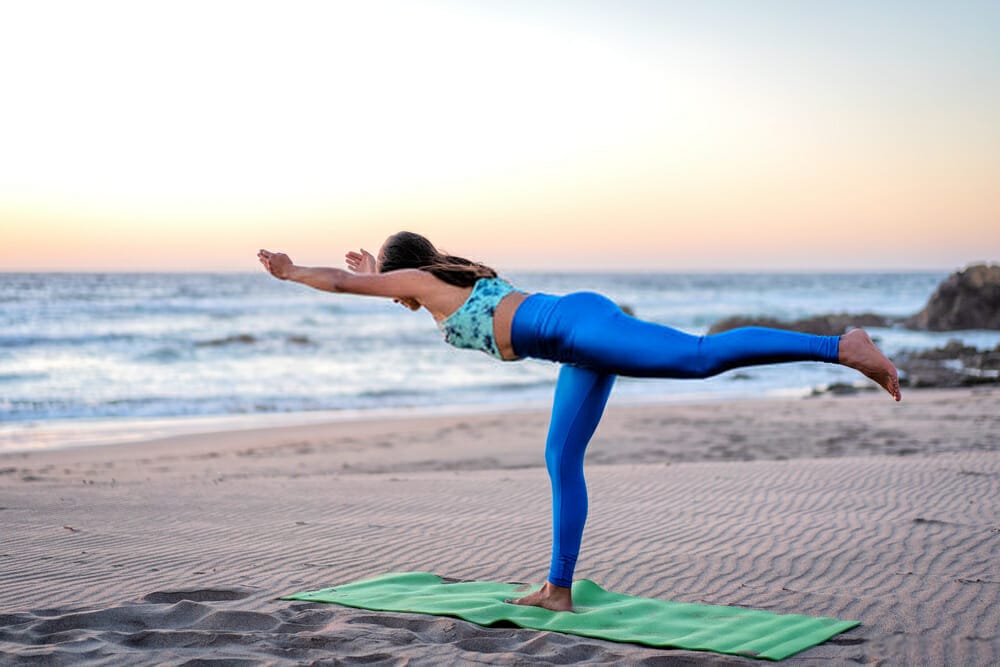
Standing Separate Leg Stretching Pose
This pose extends the legs, spine muscles, and the sciatic nerve in particular. In addition, it’s thought to help the abdominal organs and their associated processes perform better.
Triangle Pose
The next pose in the Bikram sequence is Trikonasana, or Triangle Pose, which revitalizes, strengthens, and stretches the body and mind. The hips, legs, and core would be the focus of this pose.
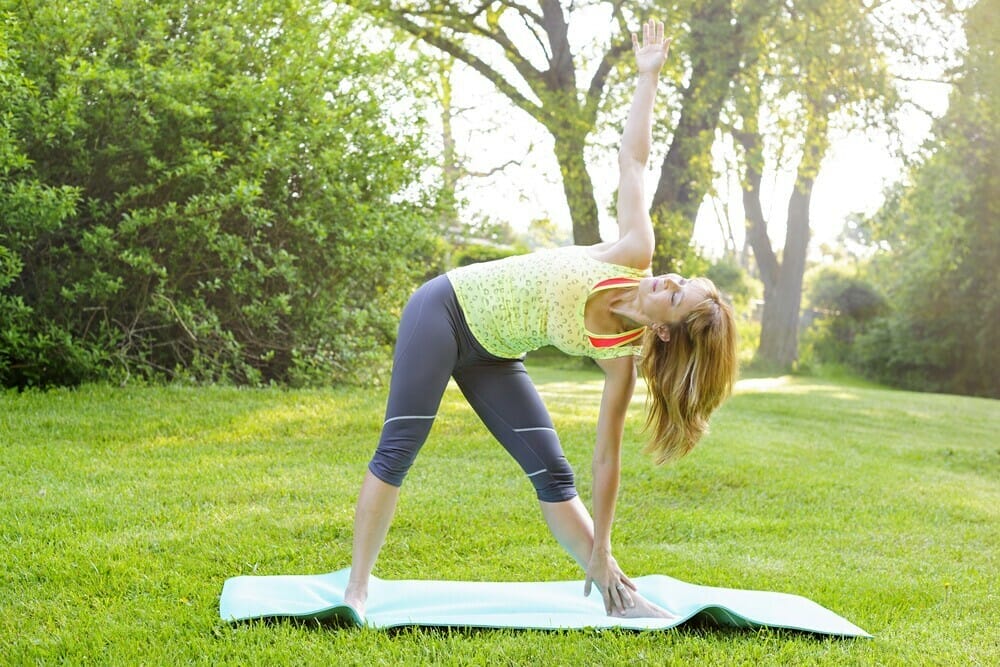
Bikram yoga's version of the Triangle position is much different from what you'll find in other styles. This posture is known as Extended Side Angle in other yoga sessions, and it's a fantastic stretch for your side body.
Standing Separate Leg Head to Knee Pose
Dandayamana Bibhaktapada Janushirasana, or Standing Separate Leg Head to Knee Pose in Sanskrit, is an intense leg stretch that opens the shoulders. The posture is used to massage the internal organs and boost metabolism.
Tree Pose
Tree Pose, or Tadasana in Bikram Yoga, helps you rebalance. This pose strengthens the ankles, knees, and hip joints while improving posture.
Toe Stand
Toe Stand, or Padangustasana, is the final pose in the standing series. This position strengthens the feet while also increasing the range of motion in the ankles, knees, and hips. It also necessitates and improves mental endurance and focus.
Corpse Pose
Corpse Pose (Savasana), everyone’s favourite yoga, comes between the standing and sitting series in Bikram yoga.
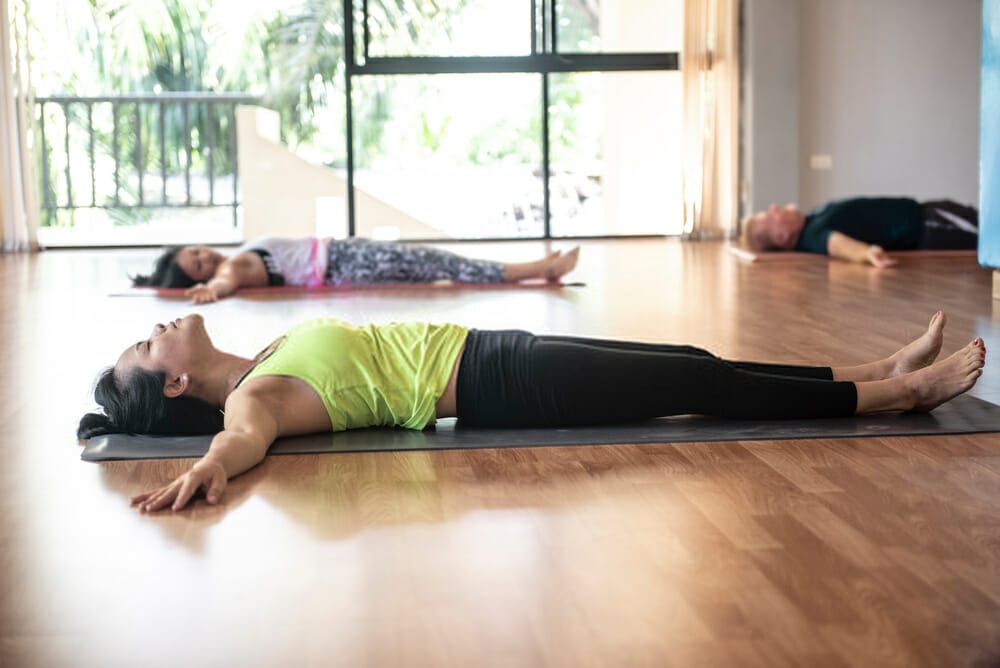
Wind Removing Pose
Take a minute to open your hips with Wind Removing Pose before continuing to the sitting series (Pavanamuktasana).
By gently stretching the lower back, this pose is good for treating lower back pain. This position also engages the core and improves hip flexibility.
Sit Up
Sit Up (Pada-Hasthasana) is a terrific position for calming your mind, activating your body, and stretching your legs in Bikram yoga.
The Head-to-Knee Pose is a version of this pose that is commonly used in other yoga systems.
Cobra Pose
Bikram is no exception when it comes to a good Cobra Pose or Bhujangasana. This pose is beneficial for stretching and strengthening the core, as well as preventing back problems.
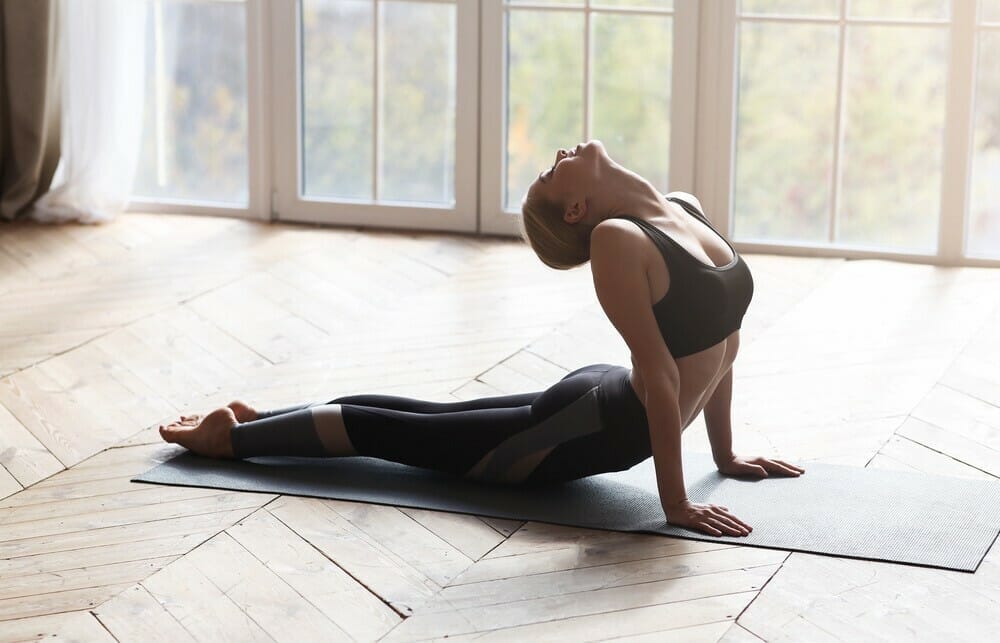
Locust Pose
Salabhasana, or Locust Pose, is another excellent backbend that strengthens while stretching. The entire body is engaged in this stance, which tones the buttocks, hips, and legs.
Full Locust Pose
Full Locust Stance (Poorna Salabhasana) strengthens the mid-body and builds on the preceding pose.
Bow Pose
Dhanurasana, or Bow Pose, continues with backbends and is a terrific pose to open your chest and shoulders. This posture is refreshing and enhances spinal mobility.

Fixed Firm Pose
Next up is Fixed Firm Pose, which gives you a break from backbends (Supta Vajrasana). You’ll stretch your leg muscles, knee joint, ankles, lower back, and hips with this position.
Half Tortoise Pose
Half Tortoise (Ardha Kurmasana) is a beautiful, soothing Bikram yoga asana. In this position, find relief in the neck and shoulders while gently expanding the hips.
Camel Pose
Camel Pose, or Ustrasana, is a challenging but rewarding position. This posture stretches the calves, improves posture, and strengthens the back.
Rabbit Pose
Rabbit Pose, or Sasangasana, is used to balance the body. It stretches the hamstring muscles and builds strength in the back, hips, and spine.
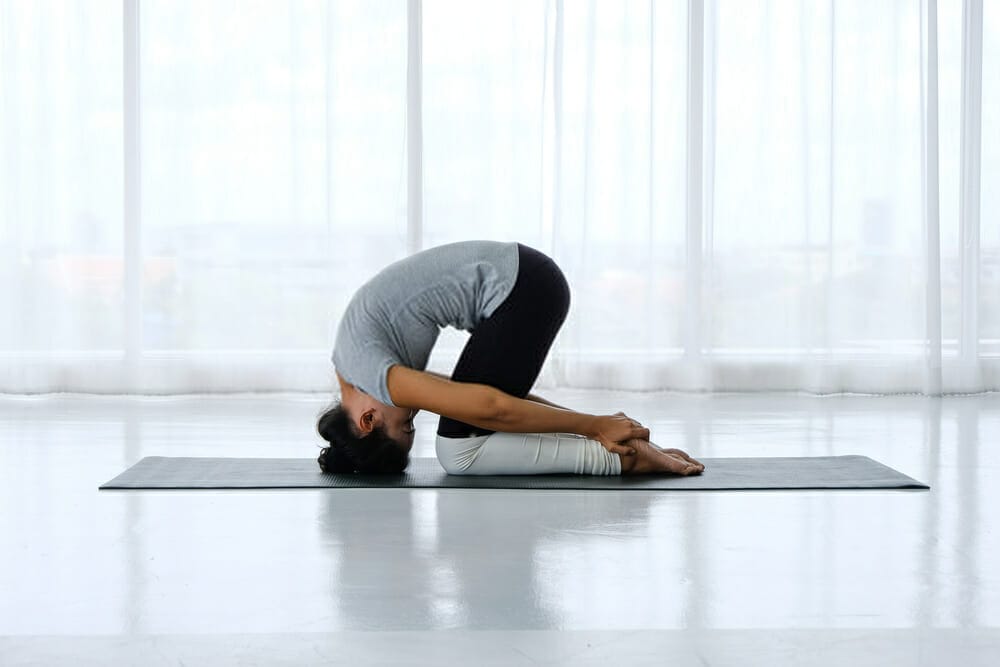
Head-to-Knee Pose and Stretching Pose
Head-to-Knee Pose (Janushirasana with Paschimottanasana) is a more rigorous seated stretch paired with Stretching Pose (Janushirasana with Paschimottanasana) to achieve the best effects.
Spine Twisting Pose
To realign your spine, execute Spine Twisting Pose (Ardha Matsyendrasana) on both sides. Half Lord of the Fishes Pose is another name for this pose used in several yoga systems.
Blowing in Firm
A kneeling posture and a pranayama exercise conclude the Bikram sequence. It’s the usage of Kapalbhati breathing in Vajrasana in particular.
What does Bikram yoga do & what is it suitable for?
Bikram’s Yoga by itself is a superb exercise regime, but it is also particularly effective when used in conjunction with other activities. Pairing the practice with other forms of exercise, for instance, helps to build flexibility and endurance.
Let’s look at some of the health benefits of Bikram yoga:
Increases Flexibility
Bikram yoga was formulated by Bikram Choudhury, an exercise analyst who has made a significant contribution to the fitness industry.
The Bikram yoga exercises specifically target muscle groups that promote flexibility and coordination while preventing injury.
Decreases Stress Levels
While the Bikram Yoga poses might appear challenging and uncomfortable, they provide better stress relief than almost any other activity out there.
With the poses and alternating breathing techniques and heat, you will find your stress levels dropping quickly and notice a more positive attitude overall.
Improves Core Strength
With all of the twisting and balancing involved, the body needs to increase core strength for stability. Bikram’s yoga is fused with deep breathing and stabilizing poses to balance the body.
Enhances Energy Levels
By engaging the core and stretching the hips, you can build up your energy levels. In addition, it is beneficial for those who are struggling to stay focused during their day-to-day routines.
Gives you clear skin
Bikram’s yoga is known for getting rid of acne and oily skin in a matter of days. Because of the room’s heat, the tight muscles all over the bodywork together to draw out impurities from the system – therefore, it works so quickly and effectively.
Revitalizes the Body
Bikram’s yoga is extremely energizing when compared to other forms of exercise. However, it is gentle enough for people of all ages and is a great way to add balance to your daily routine.
You may lose weight
The heat in the room stimulates the digestive system and increases metabolism. In addition, breathing techniques are known to be therapeutic, which helps you gain clarity and focus.
Strengthens your limbs
The poses increase stamina and strengthen limbs during Bikram’s yoga. So if you’re looking for a form of exercise that won’t hurt but still works out your muscles, Bikram may be it for you!
It Makes you mentally healthy
The poses and stretches are known to be calming. They help boost your emotional wellbeing, which is an excellent way to relax and enjoy the journey.
Keeps you healthy
There’s no way Bikram can cause health problems. The poses and the heat in the room protect everyone from illness and diseases. It otherwise develops from a sedentary lifestyle.
These are some of the things you can expect to achieve when you join the Bikram yoga community.
What are the scientifically proven benefits of Bikram yoga?
Research has shown that Bikram yoga can slow the ageing process of the body.
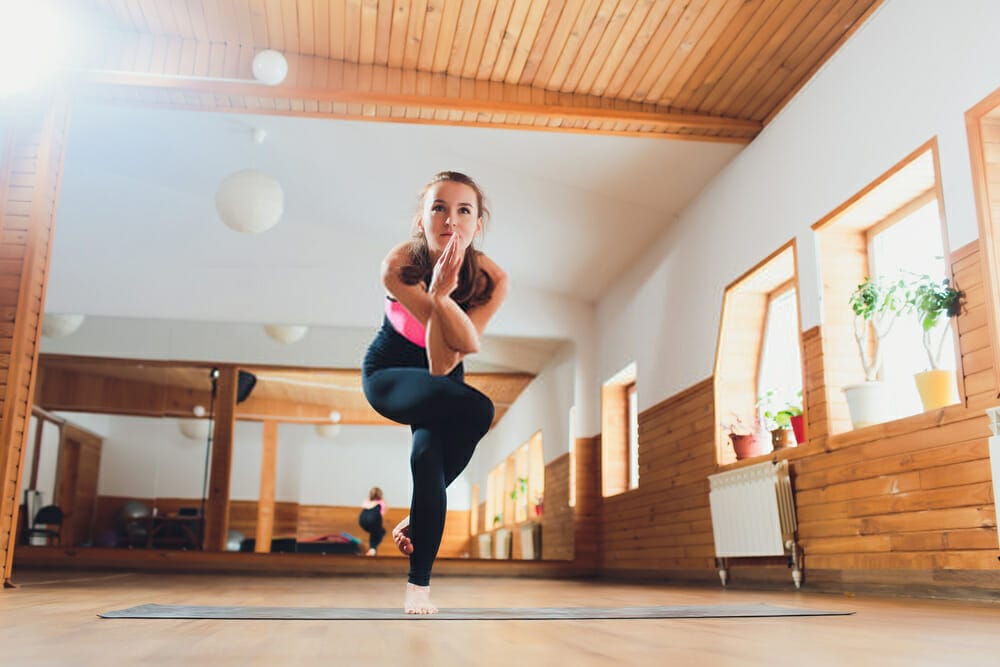
The heat generated in the room provides better circulation throughout your body, which keeps all of your muscles and tissues functioning optimally.
Because of this, you will notice visible effects faster than you would if you were doing other forms of exercise.
Pranayama or breathing exercises are used to build endurance on top of working on flexibility and core strength. The poses help to stretch out your muscles and keep you flexible, which is why the practice works so well.
Bikram yoga helps to relieve stress, depression, and anxiety. It's incredible for improving cardiovascular health as well as preventing diseases like diabetes.
This exercise is gentle enough for people of all ages to practice it without worrying about harming themselves.
What makes Bikram yoga different?
When it comes to Bikram yoga, many people practice the poses like it for the heat in the room. The heat allows people to sweat and detoxify their bodies. It also helps any aches and pains you might have to disappear quickly.
Bikram yoga has changed the landscape of exercise and fitness by altering our perceptions of possible and achievable.
It’s a more holistic approach to exercising than most of us realize and one that will generate long-lasting effects with regular practice.
Will it get me fit? Will I lose weight and tone myself up?
Bikram yoga is already helping people achieve their goals. Nearly 20 million people practise yoga every year, and the number continues to grow.
So if you're looking to lose weight or tone up your body, Bikram is one of the best options out there.
People are also noticing improvements in their skin within just a few days of beginning Bikram yoga.
Nearly one million people have sung praises about the effectiveness of Bikram as a way to simplify and cleanse their bodies naturally.
How is Bikram yoga different from other styles of yoga? Let’s compare and see!
hot yoga vs Bikram yoga
Let’s now compare Bikram yoga to hot yoga. Although heat is the most significant difference between Bikram and hot yoga, there are other essential differences.
Every Bikram yoga class consists of 26 poses and two breathing exercises repeated in the same order for 90 minutes.
There are various postures in hot yoga, and they differ depending on the class and studio.
Bikram yoga studios, or “torture chambers,” must be heated at 105 degrees with 40% humidity, according to Choudhury.
The humidity in hot yoga rooms varies, but they are usually heated to 80 and 100 degrees.
Bikram yoga studios must-have carpeted floors, front-wall mirrors, and bright lighting.
You can do hot yoga in the dark, by candlelight, or on any surface.
To be considered real Bikram yoga, instructors must be trained by Bikram Choudhury himself, and their studios must be associated.
It does not allow any music, applauding, or instructor adjustments.
Music is frequently played during hot yoga classes, which is followed by a round of applause.
During Bikram yoga, students are not allowed to chat.
Students in hot yoga are encouraged to interact with one another as well as with the instructor.
Bikram yoga vs regular yoga
Thanks to the popularity of Bikram yoga, many other yoga classes have copied or replicated its 26 poses and breathing exercises. It is done to capitalize on the success of Bikram, although it is often unsuccessful.
Bikram yoga is found worldwide in many different forms.
- The room temperature in Bikram yoga is typically much higher than other classes at 105 degrees Fahrenheit, whereas other studios or teachers might keep their classes at much cooler temperatures.
- Bikram yoga burns more calories than most other styles of yoga, which is one of the reasons it is such a popular choice among people who want to lose weight.
- There is silence in Bikram yoga classes, and students are expected to be entirely focused. While in regular yoga classes, there is music playing, and the instructor encourages some interaction between each other.
- For beginners, regular yoga classes are a better option than Bikram yoga because of the strict sequence of the 26 poses.
The poses in Bikram can be pretty challenging to do, especially if you are new to yoga.
- The rooms in regular yoga studios are usually very dimly lit, which helps practitioners concentrate on their breathing and poses, as opposed to Bikram yoga, which has bright lights on all the time.
Modo yoga vs Bikram
- Modo yoga is also known as moksha yoga.
- There are 26 postures in Bikram yoga and 40 postures in Moksha yoga.
- Pranayama is the first step in Bikram yoga, while Savasana is the first step in Moksha yoga.
- A Bikram yoga class lasts 90 minutes, while a Moksha yoga class lasts 60 minutes.
- The temperature in a Bikram yoga class is higher than in a Moksha yoga class.
- A Bikram session is prescribed, whereas a Moksha class allows for more flexibility and variation.
- In a Bikram yoga class, the instructor is authoritative and intense; however, the instructor is more soft and compassionate in a Moksha yoga class.
FAQs
How hot is Bikram yoga?
The actual heat in the room is going to vary depending upon your instructor. Some will keep the room much hotter than others.
Some studios will be more relaxed for students who are not accustomed to the heat.
The Yogi in charge of the class will let you know what to expect in advance. Mostly the temperature is kept about 105 degrees Fahrenheit.
What is the temperature in a Bikram yoga (hot yoga) class?
Yoga is practised in a sweltering room, around 105 degrees Fahrenheit. The temperature is on purpose so that the body will sweat profusely. This helps to detoxify your body and remove impurities.
The poses are designed to maximize the amount of sweating you do while you practice them, which is why it's so effective for detoxification and weight loss.
How hot is Bikram yoga compared to hot yoga?
The heat in Bikram yoga is hotter than hot yoga classes, but it is still safe for most people to do.
Hot yoga classes may be at any temperature the teacher wants them to be, which is why you might notice that some rooms can be much more excellent than others.
Bikram Yoga Classes: How to find the best classes?
Many people around the world are choosing Bikram yoga for weight loss, detoxing, and stress reduction.
There are many different Bikram yoga classes available for people who would like to join in on the fun.
- Before you decide to enrol in a class, check out your local gym or health club if they offer Bikram yoga sessions.
- Search online for “Bikram yoga” to learn all about different studios that are available in your area.
- You can also search for “hot yoga” or “yoga classes in my area” because many studios offer both.
- To find reviews of your local Bikram yoga studio, check out their website and read Yelp and Facebook reviews.
- You can also check out reviews by other people who have taken a class at that specific studio to see what it’s like before you decide to join a class yourself.
- Also, check out their classes and packages online and see what type of deals they offer to determine which one fits your needs the best.
- Make sure you ask about any extra costs, because some studios may charge a fee for specific classes, such as weekends or evenings.
What is the first-class like?
Some people wonder what the first class is like because they are nervous about trying something new.
The first Bikram yoga class will be very challenging. You might feel exhausted or faint, but you'll soon discover that this is just a very intense workout and a great way to start a new exercise routine.
You can do some things to make your first class go by faster, so you don’t get too tired before the end of the workout.
What should I expect in my first class?
Your first class will probably be very challenging, but remember that the benefits are worth it. First, make sure you arrive early, so you have time to warm up your body before the workout starts.
It usually helps people feel less stressed out and more relaxed during class. It's also a good idea to bring a towel to the studio, just if you want to take a quick break between poses.
What should I wear?
You can wear whatever you feel comfortable into class. You can wear shorts and a t-shirt or even a bathing suit, but sometimes people opt for leggings and a loose tank top. You can also wear a sports bra and stretchable shorts or pants.
Some people choose to wear a bathing suit because it is easy to wash. You can also choose to wear loose, comfortable clothing.
How long is the class?
The class will last an hour and a half. Make sure you arrive on time to make the most of your workout.
What should I bring?
You can bring water, towels, and a yoga mat. However, keep in mind that you will sweat a lot, so get an extra set of clothes with you. You also might want to bring socks or flip-flops, just in case.
Should I eat before class?
Before the class, you should try to eat 1 or 2 small meals. When you are hungry, your body will be using more energy, which means you will burn fewer calories. After the class, try to drink another 8 ounces of water.
How much water should I drink?
You should drink about 16 to 24 ounces of water an hour before class, then about 8 ounces during class to stay hydrated.
I can’t do the postures very well; will I still get the benefits?
The benefits come from the entire Bikram yoga class, not just from doing the postures. So don’t be upset if you can’t do a particular pose as well as all the others.
You shouldn't feel bad for not doing postures and everyone else because it isn't something you can take pride in.
If you stick with it and try your best, you will get the full benefits of the workout and start seeing results after a few weeks.
How soon will I start to see changes?
You should start to see positive changes by the third or fourth week. You can continue to do it after that to continue losing weight and gaining flexibility.
Should I be sore after the first Bikram yoga class?
Yes, you should be sore after the class because you are building up your muscles. However, the soreness should start to go away after the next day or two, but it will come back again when you do the next class.
Any health effects from practising Bikram yoga?
Some Bikram yoga practitioners can experience slight nausea or dizziness, but after the first class, this goes away.
However, some people also experience headaches, backaches, and leg cramps after a Bikram yoga session.
It is because you use muscles in your body that you don’t usually use during everyday activities.
Conclusion
That’s all! Now you know all about Bikram Yoga. It’s a great workout and helpful for those looking to lose weight and gain flexibility and strength.
If you're not sure if Bikram yoga is for you, it is always a good idea to try one class first, so you can see if it is the right fit before committing!
I hope you enjoyed reading this article, and if you did, please help spread it by sharing it with a friend! Have a great day!

